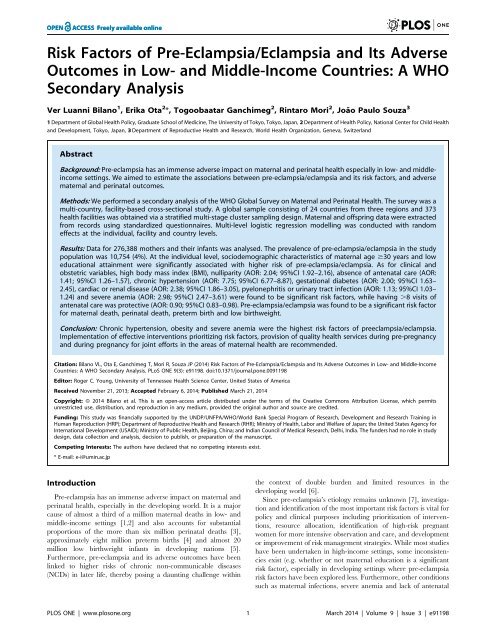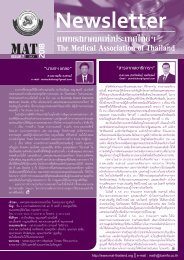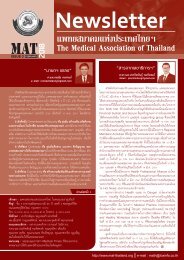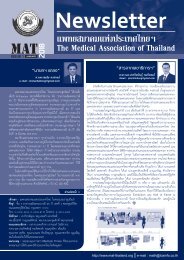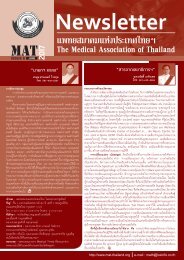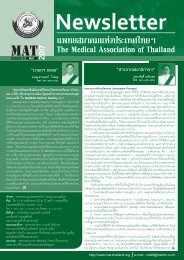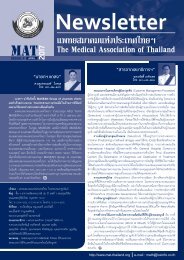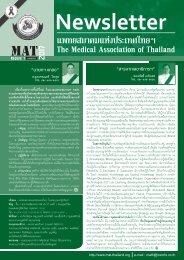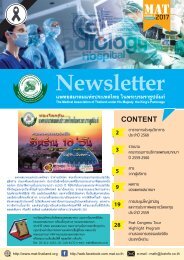risk factor for preeclampsia
You also want an ePaper? Increase the reach of your titles
YUMPU automatically turns print PDFs into web optimized ePapers that Google loves.
Risk Factors of Pre-Eclampsia/Eclampsia and Its Adverse<br />
Outcomes in Low- and Middle-Income Countries: A WHO<br />
Secondary Analysis<br />
Ver Luanni Bilano 1 , Erika Ota 2 *, Togoobaatar Ganchimeg 2 , Rintaro Mori 2 , João Paulo Souza 3<br />
1 Department of Global Health Policy, Graduate School of Medicine, The University of Tokyo, Tokyo, Japan, 2 Department of Health Policy, National Center <strong>for</strong> Child Health<br />
and Development, Tokyo, Japan, 3 Department of Reproductive Health and Research, World Health Organization, Geneva, Switzerland<br />
Abstract<br />
Background: Pre-eclampsia has an immense adverse impact on maternal and perinatal health especially in low- and middleincome<br />
settings. We aimed to estimate the associations between pre-eclampsia/eclampsia and its <strong>risk</strong> <strong>factor</strong>s, and adverse<br />
maternal and perinatal outcomes.<br />
Methods: We per<strong>for</strong>med a secondary analysis of the WHO Global Survey on Maternal and Perinatal Health. The survey was a<br />
multi-country, facility-based cross-sectional study. A global sample consisting of 24 countries from three regions and 373<br />
health facilities was obtained via a stratified multi-stage cluster sampling design. Maternal and offspring data were extracted<br />
from records using standardized questionnaires. Multi-level logistic regression modelling was conducted with random<br />
effects at the individual, facility and country levels.<br />
Results: Data <strong>for</strong> 276,388 mothers and their infants was analysed. The prevalence of pre-eclampsia/eclampsia in the study<br />
population was 10,754 (4%). At the individual level, sociodemographic characteristics of maternal age $30 years and low<br />
educational attainment were significantly associated with higher <strong>risk</strong> of pre-eclampsia/eclampsia. As <strong>for</strong> clinical and<br />
obstetric variables, high body mass index (BMI), nulliparity (AOR: 2.04; 95%CI 1.92–2.16), absence of antenatal care (AOR:<br />
1.41; 95%CI 1.26–1.57), chronic hypertension (AOR: 7.75; 95%CI 6.77–8.87), gestational diabetes (AOR: 2.00; 95%CI 1.63–<br />
2.45), cardiac or renal disease (AOR: 2.38; 95%CI 1.86–3.05), pyelonephritis or urinary tract infection (AOR: 1.13; 95%CI 1.03–<br />
1.24) and severe anemia (AOR: 2.98; 95%CI 2.47–3.61) were found to be significant <strong>risk</strong> <strong>factor</strong>s, while having .8 visits of<br />
antenatal care was protective (AOR: 0.90; 95%CI 0.83–0.98). Pre-eclampsia/eclampsia was found to be a significant <strong>risk</strong> <strong>factor</strong><br />
<strong>for</strong> maternal death, perinatal death, preterm birth and low birthweight.<br />
Conclusion: Chronic hypertension, obesity and severe anemia were the highest <strong>risk</strong> <strong>factor</strong>s of <strong>preeclampsia</strong>/eclampsia.<br />
Implementation of effective interventions prioritizing <strong>risk</strong> <strong>factor</strong>s, provision of quality health services during pre-pregnancy<br />
and during pregnancy <strong>for</strong> joint ef<strong>for</strong>ts in the areas of maternal health are recommended.<br />
Citation: Bilano VL, Ota E, Ganchimeg T, Mori R, Souza JP (2014) Risk Factors of Pre-Eclampsia/Eclampsia and Its Adverse Outcomes in Low- and Middle-Income<br />
Countries: A WHO Secondary Analysis. PLoS ONE 9(3): e91198. doi:10.1371/journal.pone.0091198<br />
Editor: Roger C. Young, University of Tennessee Health Science Center, United States of America<br />
Received November 21, 2013; Accepted February 6, 2014; Published March 21, 2014<br />
Copyright: ß 2014 Bilano et al. This is an open-access article distributed under the terms of the Creative Commons Attribution License, which permits<br />
unrestricted use, distribution, and reproduction in any medium, provided the original author and source are credited.<br />
Funding: This study was financially supported by the UNDP/UNFPA/WHO/World Bank Special Program of Research, Development and Research Training in<br />
Human Reproduction (HRP); Department of Reproductive Health and Research (RHR); Ministry of Health, Labor and Welfare of Japan; the United States Agency <strong>for</strong><br />
International Development (USAID); Ministry of Public Health, Beijing, China; and Indian Council of Medical Research, Delhi, India. The funders had no role in study<br />
design, data collection and analysis, decision to publish, or preparation of the manuscript.<br />
Competing Interests: The authors have declared that no competing interests exist.<br />
* E-mail: e-i@umin.ac.jp<br />
Introduction<br />
Pre-eclampsia has an immense adverse impact on maternal and<br />
perinatal health, especially in the developing world. It is a major<br />
cause of almost a third of a million maternal deaths in low- and<br />
middle-income settings [1,2] and also accounts <strong>for</strong> substantial<br />
proportions of the more than six million perinatal deaths [3],<br />
approximately eight million preterm births [4] and almost 20<br />
million low birthweight infants in developing nations [5].<br />
Furthermore, pre-eclampsia and its adverse outcomes have been<br />
linked to higher <strong>risk</strong>s of chronic non-communicable diseases<br />
(NCDs) in later life, thereby posing a daunting challenge within<br />
the context of double burden and limited resources in the<br />
developing world [6].<br />
Since pre-eclampsia’s etiology remains unknown [7], investigation<br />
and identification of the most important <strong>risk</strong> <strong>factor</strong>s is vital <strong>for</strong><br />
policy and clinical purposes including prioritization of interventions,<br />
resource allocation, identification of high-<strong>risk</strong> pregnant<br />
women <strong>for</strong> more intensive observation and care, and development<br />
or improvement of <strong>risk</strong> management strategies. While most studies<br />
have been undertaken in high-income settings, some inconsistencies<br />
exist (e.g. whether or not maternal education is a significant<br />
<strong>risk</strong> <strong>factor</strong>), especially in developing settings where pre-eclampsia<br />
<strong>risk</strong> <strong>factor</strong>s have been explored less. Furthermore, other conditions<br />
such as maternal infections, severe anemia and lack of antenatal<br />
PLOS ONE | www.plosone.org 1 March 2014 | Volume 9 | Issue 3 | e91198
Pre-Eclampsia Risk Factors and Adverse Outcomes<br />
care that are more prevalent in less developed regions require<br />
further investigation and validation of findings [8–10]. In addition,<br />
previous research has been limited by small sample sizes [11] or<br />
analytic methods that do not properly take into account the effects<br />
of higher-level <strong>factor</strong>s [12,13].<br />
As <strong>for</strong> pre-eclampsia’s adverse maternal and perinatal outcomes,<br />
there is limited in<strong>for</strong>mation and research assessing the<br />
magnitude of <strong>risk</strong>s in low-resource areas where the impact is<br />
thought to be more severe [14]. Furthermore, small sample sizes<br />
or lack of adjustment <strong>for</strong> some important confounders are notable<br />
weaknesses that have restricted previous research [11,15].<br />
This study thus aimed to conduct multi-level analyses of data<br />
from the WHO Global Survey on Maternal and Perinatal Health<br />
including 23 developing countries in Africa, Latin America and<br />
Asia in order to estimate associations between maternal, country<br />
characteristics and pre-eclampsia/eclampsia, and to estimate the<br />
magnitude of <strong>risk</strong>s <strong>for</strong> pre-eclampsia/eclampsia’s adverse maternal<br />
and perinatal outcomes.<br />
Methods<br />
Ethics Statement<br />
The protocol was approved by the WHO’s Scientific and<br />
Ethical Review Group and Ethics Review Committee and that of<br />
each country independently [16]. Written consent was obtained<br />
from each participating country’s ministry of health and each<br />
selected facility’s director [16]. Because the study involved clusterlevel<br />
inclusion and records data extraction without individual<br />
identifying in<strong>for</strong>mation, individual in<strong>for</strong>med consent was not<br />
obtained.<br />
Study design<br />
We undertook a secondary analysis of the WHO Global Survey<br />
on Maternal and Perinatal Health. Details of this survey’s<br />
methodology are available elsewhere [16]. To summarize, the<br />
survey was a multi-country, facility-based cross-sectional study. It<br />
was conducted between 2004 and 2005 in Africa and Latin<br />
America, and between 2007 and 2008 in Asia. A global sample of<br />
countries and health facilities was obtained via a stratified<br />
multistage cluster sampling design. Twenty-four countries from<br />
three regions were included in the survey: Algeria, Angola,<br />
Democratic Republic of Congo, Niger, Nigeria, Kenya, and<br />
Uganda from Africa; Argentina, Brazil, Cuba, Ecuador, Mexico,<br />
Nicaragua, Paraguay, and Peru from Latin America; and<br />
Cambodia, China, India, Japan, Nepal, Philippines, Sri Lanka,<br />
Thailand, and Vietnam from Asia. For each country, the capital<br />
city and two randomly selected provinces were included in the<br />
sample. Only health facilities with caesarean section (C-section)<br />
capacities and with reported annual deliveries of at least 1,000<br />
were eligible <strong>for</strong> inclusion. Up to seven facilities per country were<br />
randomly selected. A total of 373 facilities were included in the<br />
survey. The recruitment and data collection period varied<br />
depending on the volume of deliveries in the sampled facilities.<br />
Specifically, it was set <strong>for</strong> three months <strong>for</strong> facilities with up to<br />
6,000 annual deliveries and two months <strong>for</strong> those with more than<br />
6,000 annual deliveries. All pregnant women admitted <strong>for</strong> delivery<br />
during the recruitment period were included.<br />
Data Sources<br />
Data <strong>for</strong> individuals and institutions were sourced from the<br />
WHO Global Survey on Maternal and Perinatal Health.<br />
Individual data were obtained via direct extraction from patient<br />
records by trained medical personnel within seven days after<br />
delivery or be<strong>for</strong>e maternal hospital discharge. Institutional data<br />
were collected using a standard <strong>for</strong>m by hospital coordinators in<br />
consultation with the director or head of obstetrics, and country<br />
in<strong>for</strong>mation was obtained from the World Bank [17] and literature<br />
[18].<br />
Main Outcomes Variable Definitions<br />
Due to secondary data limitations and based on previous<br />
research [13] pre-eclampsia and its complication, eclampsia, were<br />
combined into a single outcome variable. Pre-eclampsia was<br />
defined as high blood pressure ($140 mmHg systolic or<br />
$90 mmHg diastolic, or increases of 30 mmHg systolic or<br />
15 mmHg diastolic from the baseline on at least two occasions<br />
six or more hours apart) that develops from the 20 th gestational<br />
week in a previously normotensive woman, and proteinuria. The<br />
outcome can be based on having the recorded diagnosis or on<br />
blood pressure and urine test findings, even without specifying the<br />
condition. Eclampsia was defined as the onset of convulsions<br />
described as grand-mal type seizures first appearing be<strong>for</strong>e or<br />
during labour, or within 48 hours from delivery, and/or coma<br />
unrelated to other cerebral conditions in women with preeclamptic<br />
signs and symptoms.<br />
Adverse maternal and perinatal outcomes including maternal<br />
death, perinatal death, preterm birth and low birthweight were<br />
investigated. Maternal death was defined as intrahospital death of<br />
a woman that occurred on or be<strong>for</strong>e the 8 th day postpartum.<br />
Perinatal death was defined as early neonatal death (i.e.<br />
intrahospital death of an infant that occurred on or be<strong>for</strong>e the<br />
7 th day after delivery) or stillbirth (fresh or macerated). Preterm<br />
birth was defined as livebirth occurring at less than 37 completed<br />
gestational weeks and low birthweight was defined as birthweight<br />
,2500 grams of a liveborn infant regardless of gestational age.<br />
Independent Variables Definitions<br />
The individual characteristics investigated were: maternal age,<br />
marital status, maternal educational level, maternal body mass<br />
index (BMI), parity, maternal clinical conditions (chronic hypertension,<br />
gestational diabetes, cardiac/renal disease, pyelonephritis<br />
or urinary infection, severe anemia) and number of antenatal<br />
visits. Maternal age was defined as age in completed years at the<br />
time of delivery. Participants were classified into four categories:<br />
,20, 20 to 29, 30 to 34 and $35 years. Marital status was<br />
dichotomized into single/widowed/divorced/separated and married/cohabiting<br />
with the infant’s father. Maternal education was<br />
based on the number of years of schooling. The UNESCO<br />
international standard classification of education was adopted<br />
allocating participants to one of five levels: no education (0 years),<br />
primary (1 to 6 years), lower secondary (7 to 9 years), upper<br />
secondary (10 to 12 years) and post-secondary/tertiary (.12<br />
years).<br />
Maternal BMI was computed as the ratio of maternal weight in<br />
kilograms and the square of maternal height in meters. In Africa<br />
and Latin America, maternal weight was recorded at the last<br />
antenatal care visit, while in Asia, it was recorded at admission <strong>for</strong><br />
delivery. Maternal BMI was categorized into four ranges: ,20, 20<br />
to ,26, 26 to ,35 and $35 kg/m 2 . Parity was defined as the<br />
number of previous births and was dichotomized into nulliparity<br />
and multiparity. Maternal clinical conditions were determined<br />
based on the recorded diagnosis or laboratory findings, even<br />
without specifying the condition. Chronic hypertension was<br />
defined as high blood pressure diagnosed prior to the onset of<br />
pregnancy or be<strong>for</strong>e the 20 th gestational week. Severe anemia was<br />
defined as a haemoglobin level of ,7 g/dL during pregnancy.<br />
The number of antenatal visits was irrespective of whether the<br />
antenatal clinic was different from the admission facility. This was<br />
PLOS ONE | www.plosone.org 2 March 2014 | Volume 9 | Issue 3 | e91198
Pre-Eclampsia Risk Factors and Adverse Outcomes<br />
categorized into four based on WHO recommendations <strong>for</strong><br />
antenatal care: 0, 1 to 3, 4 to 8 and .8 visits.<br />
Institutional Characteristics<br />
We considered institutional in<strong>for</strong>mation related to maternal and<br />
perinatal care, such as: availability of laboratory tests; anesthesiology<br />
resources; services <strong>for</strong> intrapartum care, delivery and<br />
newborn care; and the presence of basic emergency medical and<br />
obstetric care facilities, intensive care units, and training resources.<br />
As with previous research using the WHO Global Survey data, we<br />
applied institutional capacity index scoring to gauge facilities’<br />
levels of resources as well as their maternal and perinatal care<br />
service provision capabilities. Points were assigned <strong>for</strong> the<br />
availability of resources or services and the unweighted total was<br />
obtained. We then dichotomized the institutional capacity index<br />
score into higher capacity (greater than the mean <strong>for</strong> all facilities)<br />
and lower capacity (less than or equal to the mean <strong>for</strong> all facilities).<br />
Country Characteristics<br />
The country characteristics considered were gross national<br />
income (GNI) per capita and maternal mortality ratio (MMR). We<br />
categorized GNI per capita from the World Development<br />
Indicators according to World Bank definitions of low income<br />
($935 or less), lower-middle income ($936 to $3,705) and uppermiddle<br />
income ($3,706 to $11,455). MMRs (maternal deaths per<br />
100,000 livebirths) were obtained from and followed The Lancet<br />
series on maternal and child mortality’s categorization of low<br />
(below 100), moderate (100 to 299), high (300 to 549) and very<br />
high (550 and above) [18].<br />
Study Population<br />
The study population <strong>for</strong> the secondary analyses included<br />
women with singleton neonates of at least 20 weeks of gestation.<br />
Those with missing in<strong>for</strong>mation on the inclusion criteria and on<br />
the pre-eclampsia outcome were excluded. Japan was also<br />
excluded due to the study’s focus on developing settings.<br />
Statistical Analysis<br />
Statistical analyses were conducted using Stata/MP version 12.1<br />
(Stata Corp LP, College Station, Texas). Descriptive statistics (i.e.<br />
proportions) to examine the distribution of the outcomes and<br />
independent variables were generated. Univariate logistic regression<br />
analyses were also conducted <strong>for</strong> initial inspection of the<br />
associations between the outcomes and independent variables. For<br />
the main objectives, multi-level multiple regression modelling was<br />
applied. In general, this involved three levels corresponding to the<br />
individual, institutional and country characteristics with random<br />
effects at the facility and country levels to account <strong>for</strong> unmeasured<br />
higher-level <strong>factor</strong>s and <strong>for</strong> clustering due to the sampling design.<br />
Significance testing <strong>for</strong> random effects was conducted via<br />
likelihood ratio tests which involved comparing nested models<br />
with models that included additional higher levels. A p-value of<br />
,0.05 was considered statistically significant. For the associations<br />
between pre-eclampsia/eclampsia and the individual, institutional<br />
and country characteristics, a single logistic model was employed<br />
to simultaneously estimate the relationship of the independent<br />
variables with the outcome. To estimate associations of <strong>preeclampsia</strong>/eclampsia<br />
with adverse maternal and perinatal outcomes,<br />
we created separate logistic regression models <strong>for</strong> each of<br />
the adverse outcomes and adjusted <strong>for</strong> important confounders<br />
identified from literature and the results of the previous <strong>risk</strong> <strong>factor</strong><br />
analysis. Two types of sensitivity analyses were conducted <strong>for</strong> all<br />
models to address missing BMI in<strong>for</strong>mation (.10% <strong>for</strong> a number<br />
of countries) by: a) including a missing category <strong>for</strong> BMI and b)<br />
excluding countries with more than 10% of BMI data missing,<br />
namely: Kenya (86%), Brazil (67%), Angola (40%), Argentina<br />
(32%), Uganda (22%), Philippines (20%), and Peru (13%).<br />
Results<br />
The WHO Global Survey on Maternal and Perinatal Health<br />
dataset included a total of 290,610 deliveries. For this secondary<br />
analysis, data <strong>for</strong> 276,388 mothers and their infants was retained<br />
after excluding Japan, multiple births, deliveries at less than 20<br />
weeks of gestation and those with missing in<strong>for</strong>mation on the<br />
inclusion criteria and pre-eclampsia/eclampsia outcome. Overall<br />
and regional profiles <strong>for</strong> the study population are provided in<br />
Table 1. The majority of mothers were aged between 20 to 29<br />
years old (59%), were married or cohabiting with the infant’s<br />
father (86%) or had given birth previously (57%). As <strong>for</strong> education<br />
and BMI, the upper secondary level (37%) and the 20 to ,26 kg/<br />
m 2 (48%) category had the greatest proportions of mothers<br />
respectively. At the facility level, the majority (65%) of deliveries<br />
was in institutions with higher capacity index scores except <strong>for</strong><br />
Africa, where a greater portion (63%) of mothers delivered in<br />
lower-capacity facilities. At the country level, the greatest<br />
proportions were in the lower-middle GNI per capita category<br />
(49%) and the low MMR level (60%) overall, but these<br />
characteristics varied across regions.<br />
The prevalence of pre-eclampsia/eclampsia in the study<br />
population was 10,754 (4%), but there was much variation<br />
between and within countries. Regional, country and facility <strong>preeclampsia</strong>/eclampsia<br />
prevalence profiles are provided in Table 2<br />
and Figure 1. Across regions, pre-eclampsia/eclampsia prevalences<br />
at the country level ranged from less than 1% in Angola to 8%<br />
in Brazil. Such variability was also observed among countries<br />
within the same region. The highest maternal mortality was<br />
observed in Nigeria at 8 (3%), and the highest perinatal mortality<br />
was in the Democratic Republic of Congo at 44 (22%) associated<br />
with pre-eclampsia/eclampsia. The highest prevalence of preterm<br />
birth was Angola at 35 (76%) and the highest rate of low<br />
birthweight was in Sri Lanka at 83 (40%) associated with <strong>preeclampsia</strong>/eclampsia.<br />
Overall and regional profiles <strong>for</strong> pre-eclampsia/eclampsia <strong>risk</strong><br />
<strong>factor</strong>s are provided in Table 1. Table 3 shows the adjusted oddsratios<br />
(AOR) <strong>for</strong> pre-eclampsia/eclampsia <strong>risk</strong> <strong>factor</strong>s obtained via<br />
multi-level multiple logistic regression analyses. At the individual<br />
level, sociodemographic characteristics of older maternal age ($30<br />
years), lower than secondary education attainment such as primary<br />
level (AOR: 1.11; 95% confidence interval (CI): 1.01–1.22) or no<br />
education (AOR: 1.22; 95%CI 1.07–1.39), high BMI ($26 kg/<br />
m 2 ) ($35 kg/m 2 , AOR: 3.90; 95%CI 3.52–4.33), nulliparity<br />
(AOR: 2.04; 95%CI 1.92–2.16), were significantly associated with<br />
higher odds of having pre-eclampsia/eclampsia. As <strong>for</strong> clinical<br />
variables, history of chronic hypertension (AOR: 7.75; 95%CI<br />
6.77–8.87), gestational diabetes (AOR: 2.00; 95%CI 1.63–2.45),<br />
cardiac or renal disease (AOR: 2.38; 95%CI 1.86–3.05),<br />
pyelonephritis or urinary tract infection (AOR: 1.13; 95%CI<br />
1.03–1.24) and severe anemia (AOR: 2.98; 95%CI 2.47–3.61)<br />
were also significantly associated with higher pre-eclampsia/<br />
eclampsia <strong>risk</strong>s. Antenatal care non-attendance was associated<br />
with significantly higher pre-eclampsia/eclampsia <strong>risk</strong>s (AOR:<br />
1.41; 95%CI 1.26–1.57) while having .8 visits was protective<br />
(AOR: 0.90; 95%CI 0.83–0.98). Lastly at the country level, a<br />
significant increasing trend in pre-eclampsia/eclampsia odds was<br />
observed with rising GNI per capita. Similar findings were<br />
obtained from the sensitivity analyses.<br />
PLOS ONE | www.plosone.org 3 March 2014 | Volume 9 | Issue 3 | e91198
Pre-Eclampsia Risk Factors and Adverse Outcomes<br />
Table 1. Overall and regional distribution of <strong>risk</strong> <strong>factor</strong>s <strong>for</strong> pre-eclampsia/eclampsia.<br />
Characteristic Deliveries Pre-eclampsia/eclampsia<br />
N % n %<br />
Individual<br />
Maternal age<br />
,20 34,824 12.6 1,491 4.3<br />
20 to 29 162,466 58.9 5,531 3.4<br />
30 to 34 49,117 17.8 2,022 4.1<br />
. =35 29,461 10.7 1,696 5.8<br />
Marital status<br />
Single/divorced/separated/widowed/other 37,356 13.6 1,945 5.2<br />
Married/cohabiting 238,193 86.4 8,764 3.7<br />
Education<br />
None 20,735 8.8 602 2.9<br />
Primary 54,813 23.4 2,345 4.3<br />
Lower secondary 35,370 15.1 1,276 3.6<br />
Upper secondary 87,574 37.4 3,551 4.0<br />
Post-secondary/tertiary 35,881 15.3 1,462 4.1<br />
BMI (kg/m 2 )<br />
,20 7,707 3.3 156 2.0<br />
20 to ,26 111,049 47.7 2,803 2.5<br />
26 to ,35 105,905 45.5 4,737 4.5<br />
. =35 8,221 3.5 888 10.8<br />
Parity<br />
Nulliparous 118,348 43.0 5,527 4.7<br />
Multiparous 156,589 57.0 5,178 3.3<br />
Chronic hypertension<br />
Yes 2,334 0.8 653 28.0<br />
No 273,769 99.2 10,093 3.7<br />
Gestational diabetes<br />
Yes 1,940 0.7 204 10.5<br />
No 274,163 99.3 10,544 3.8<br />
Cardiac/renal disease<br />
Yes 1,254 0.4 151 12.0<br />
No 274,848 99.6 10,597 3.9<br />
Pyelonephritis/urinary tract infection<br />
Yes 18,230 6.6 1,169 6.4<br />
No 257,825 93.4 9,574 3.7<br />
Severe anemia<br />
Yes 1,529 0.6 192 12.6<br />
No 274,555 99.4 10,555 3.8<br />
Antenatal care visits<br />
0 12,750 5.2 689 5.4<br />
1to3 67,124 27.4 2,217 3.3<br />
4to8 127,162 52.0 5,088 4.0<br />
.8 37,658 15.4 1,556 4.1<br />
Institutional<br />
Facility capacity<br />
Lower 96,723 35.0 2,112 2.2<br />
Higher 179,665 65.0 8,642 4.8<br />
Country<br />
PLOS ONE | www.plosone.org 4 March 2014 | Volume 9 | Issue 3 | e91198
Pre-Eclampsia Risk Factors and Adverse Outcomes<br />
Table 1. Cont.<br />
Characteristic Deliveries Pre-eclampsia/eclampsia<br />
N % n %<br />
GNI per capita<br />
Low 83,915 30.4 2,045 2.4<br />
Lower-middle 134,280 48.6 5,185 3.9<br />
Upper-middle 58,193 21.0 3,524 6.1<br />
Maternal mortality ratio<br />
Low 166,660 60.3 7,272 4.4<br />
Moderate 47,117 17.0 1,880 4.0<br />
High 57,217 20.7 1,556 2.7<br />
Very high 5,394 2.0 46 0.8<br />
doi:10.1371/journal.pone.0091198.t001<br />
Table 2. Distribution of pre-eclampsia and its adverse maternal and perinatal outcomes in the study population by region and<br />
country.<br />
Region Country All Deliveries Pre-eclampsia<br />
Deliveries Maternal death Perinatal death Preterm birth Low birthweigh<br />
N n % n % n % n % n %<br />
Africa 77,884 1,804 2.32 25 1.39 296 16.46 469 26.71 400 23.92<br />
Algeria 15,273 202 1.32 1 0.50 23 11.39 53 27.32 63 36.00<br />
Angola 5,394 46 0.85 1 2.17 8 17.39 35 76.09 10 21.74<br />
DRC* 8,404 199 2.37 8 4.0 44 22.11 33 17.10 35 18.13<br />
Kenya 18,767 506 2.70 3 0.59 99 19.6 161 32.33 158 32.58<br />
Niger 8,123 88 1.08 1 1.14 12 13.64 11 12.79 19 22.35<br />
Nigeria 8,699 271 3.12 8 2.97 53 19.56 84 31.94 54 22.41<br />
Uganda 13,224 492 3.72 3 0.61 57 11.70 92 19.33 31 21.38<br />
Latin America 95,296 5,718 6.00 3 0.05 186 3.26 1,176 20.96 1,285 23.56<br />
Argentina 10,335 334 3.23 NR 6 1.80 93 28.01 91 28.89<br />
Brazil 14,625 1,203 8.23 1 0.08 35 2.94 200 16.82 242 21.30<br />
Cuba 12,521 477 3.81 NR 19 3.98 83 17.89 89 20.05<br />
Ecuador 12,310 818 6.65 1 0.12 14 1.71 97 12.28 160 20.20<br />
Mexico 20,712 1,510 7.29 1 0.07 51 3.38 381 25.73 364 25.26<br />
Nicaragua 5,599 256 4.57 NR 10 3.91 38 15.28 51 20.65<br />
Paraguay 3,374 166 4.92 NR 11 6.67 44 26.67 40 25.64<br />
Peru 15,820 954 6.03 NR 40 4.19 240 25.48 248 27.49<br />
Asia 103,208 3,232 3.13 22 0.68 307 9.48 868 27.26 1,090 34.45<br />
Cambodia 5,458 155 2.84 1 0.64 20 12.82 48 31.37 52 34.67<br />
China 14,373 402 2.80 1 0.25 13 3.23 81 20.66 76 20.27<br />
India 24,421 1,123 4.60 14 1.25 177 15.76 391 35.07 444 39.71<br />
Nepal 8,265 180 2.18 2 1.08 20 10.75 43 24.43 69 38.12<br />
Philippines 13,169 738 5.60 4 0.54 60 8.13 146 20.17 244 33.56<br />
Sri Lanka 14,891 208 1.40 NR 10 4.81 68 32.69 83 39.90<br />
Thailand 9,656 272 2.82 NR 5 1.84 70 25.93 91 35.00<br />
Vietnam 12,975 154 1.19 NR 2 1.30 21 14.38 61 13.65<br />
*Democratic Republic of Congo; NR- not reported.<br />
doi:10.1371/journal.pone.0091198.t002<br />
PLOS ONE | www.plosone.org 5 March 2014 | Volume 9 | Issue 3 | e91198
Pre-Eclampsia Risk Factors and Adverse Outcomes<br />
Figure 1. Pre-eclampsia prevalence per facility by country and region. Plot showing prevalence of pre-eclampsia per facility by country and<br />
region (Africa, Asia and Latin America).<br />
doi:10.1371/journal.pone.0091198.g001<br />
For adverse maternal and perinatal outcomes, overall prevalences<br />
were less than 335 (1%) <strong>for</strong> maternal death, 7,404 (3%) <strong>for</strong><br />
perinatal death, 27,611 (10%) <strong>for</strong> preterm birth and 27,348 (10%)<br />
<strong>for</strong> low birthweight. Prevalences of the adverse outcomes by region<br />
and country are given in Table 2. Table 4 provides the adjusted<br />
odds-ratios <strong>for</strong> adverse maternal and perinatal outcomes obtained<br />
via multi-level logistic regression analyses. Random effects <strong>for</strong> the<br />
institutional and country levels in each model were shown to be<br />
significant from likelihood-ratio tests. For maternal death (AOR:<br />
4.48; 95%CI 2.99–6.69) and perinatal death (AOR: 1.87; 95%CI<br />
1.66–2.11), preterm birth (AOR: 2.86; 95%CI 2.68–3.06) and low<br />
birthiweight (AOR: 2.32; 95%CI 2.16–2.50), pre-eclampsia/<br />
eclampsia was found to be a significant <strong>risk</strong> <strong>factor</strong>. Similar<br />
findings were obtained from the sensitivity analyses.<br />
Discussion<br />
To the authors’ knowledge, this is the first multi-level, multicountry<br />
analyses dealing with pre-eclampsia/eclampsia <strong>risk</strong> <strong>factor</strong>s<br />
and its adverse outcomes including maternal deaths focusing on<br />
developing settings. Also among the strengths of this study are the<br />
large sample size and the application of standardized questionnaires<br />
across facilities, countries and regions. The prevalences of<br />
pre-eclampsia/eclampsia in the study population showed considerable<br />
variation at both the country and facility levels. At the<br />
individual level, a history of chronic hypertension, a BMI $35 kg/<br />
m 2 , and severe anemia significantly increased the <strong>risk</strong> of <strong>preeclampsia</strong>/eclampsia<br />
by three times or more. Other significant<br />
higher maternal <strong>risk</strong> <strong>factor</strong>s (twice the odds or greater) included<br />
having cardiac or renal disease, having diabetes, being nulliparous<br />
and being $30 years of age. Mothers diagnosed with <strong>preeclampsia</strong>/eclampsia<br />
were found to be significantly at four times<br />
the <strong>risk</strong> of maternal death than mothers who did not have <strong>preeclampsia</strong>/eclampsia.<br />
Our analysis found that protective <strong>factor</strong>s<br />
<strong>for</strong> <strong>preeclampsia</strong>/eclampsia included .8 antenatal care visits<br />
compared with 4–8 visits. The MMR was found to be significantly<br />
associated with pre-eclampsia/eclampsia <strong>risk</strong> <strong>factor</strong>s. The condition<br />
was also shown to have a higher <strong>risk</strong> <strong>for</strong> perinatal death,<br />
preterm birth and low birth weight. These findings support<br />
previous research [3,4].<br />
The variation of pre-eclampsia/eclampsia prevalences is perhaps<br />
not only reflective of the variability in maternal <strong>risk</strong>-<strong>factor</strong><br />
distribution, but may also be attributed to differences in facility<br />
and country characteristics, such as diagnostic capacities or<br />
accessibility of services. While the facility’s referral level is also a<br />
<strong>factor</strong>, considerable variability was still observed even after<br />
stratification on this variable. The above observations are<br />
supported by findings that GNI per capita are significant <strong>preeclampsia</strong>/eclampsia<br />
<strong>risk</strong> <strong>factor</strong>s. This may be explained by<br />
countries with lower GNI per capita having less diagnostic<br />
capabilities to identify pre-eclampsia/eclampsia cases. Lower GNI<br />
per capita may also be reflective of socioeconomic <strong>factor</strong>s<br />
associated with poor access to healthcare services. These findings<br />
suggest probable underestimation of pre-eclampsia/eclampsia<br />
prevalences in low-resource settings as well as failure to identify<br />
high-<strong>risk</strong> pregnant women <strong>for</strong> proper management, potentially<br />
PLOS ONE | www.plosone.org 6 March 2014 | Volume 9 | Issue 3 | e91198
Pre-Eclampsia Risk Factors and Adverse Outcomes<br />
Table 3. Adjusted odds ratios (ORs) of <strong>risk</strong> <strong>factor</strong>s <strong>for</strong> pre-eclampsia/eclampsia.<br />
Risk <strong>factor</strong> Adjusted OR (95% CI) p-value<br />
Individual<br />
Maternal age<br />
,20 0.97 (0.89–1.05) 0.458<br />
20 to 29 Ref<br />
30 to 34 1.40 (1.31–1.51) ,0.001<br />
. =35 1.95 (1.80–2.12) ,0.001<br />
Marital status<br />
Single/divorced/separated/widowed/other 0.98 (0.90–1.06) 0.577<br />
Married/cohabiting<br />
Ref<br />
Education<br />
None 1.22 (1.07–1.39) 0.003<br />
Primary 1.11 (1.01–1.22) 0.033<br />
Lower secondary 1.05 (0.95–1.17) 0.347<br />
Upper secondary 1.06 (0.98–1.15) 0.172<br />
Post-secondary/tertiary<br />
Ref<br />
BMI (kg/m 2 )<br />
,20 0.86 (0.72–1.03) 0.105<br />
20 to ,26 Ref<br />
26 to ,35 1.71 (1.61–1.81) ,0.001<br />
. =35 3.90 (3.52–4.33) ,0.001<br />
Parity<br />
Nulliparous 2.04 (1.92–2.16) ,0.001<br />
Multiparous<br />
Ref<br />
History of chronic hypertension<br />
Yes 7.75 (6.77–8.87) ,0.001<br />
No<br />
Ref<br />
Gestational diabetes<br />
Yes 2.00 (1.63–2.45) ,0.001<br />
No<br />
Ref<br />
Cardiac/renal disease<br />
Yes 2.38 (1.86–3.05) ,0.001<br />
No<br />
Ref<br />
Pyelonephritis/urinary tract infection<br />
Yes 1.13 (1.03–1.24) 0.007<br />
No<br />
Ref<br />
Severe anemia<br />
Yes 2.98 (2.47–3.61) ,0.001<br />
No<br />
Ref<br />
Antenatal care visits<br />
0 1.41 (1.26–1.57) ,0.001<br />
1to3 1.01 (0.94–1.08) 0.752<br />
4to8<br />
Ref<br />
.8 0.90 (0.83–0.98) 0.017<br />
Institutional<br />
Facility capacity<br />
Lower 0.47 (0.37–0.60) ,0.001<br />
Higher<br />
Ref<br />
Country<br />
GNI per capita<br />
Low<br />
Ref<br />
PLOS ONE | www.plosone.org 7 March 2014 | Volume 9 | Issue 3 | e91198
Pre-Eclampsia Risk Factors and Adverse Outcomes<br />
Table 3. Cont.<br />
Risk <strong>factor</strong> Adjusted OR (95% CI) p-value<br />
Lower-middle 2.04 (1.03–4.02) 0.040<br />
Upper-middle 3.55 (1.57–8.02) 0.002<br />
Maternal mortality ratio<br />
Low<br />
Ref<br />
Moderate 1.97 (1.11–3.48) 0.020<br />
High 1.73 (0.78–3.84) 0.180<br />
Very high 0.50 (0.16–1.55) 0.231<br />
Three-level structure logistic random effects regression models were used to obtain the Adjusted ORs: individual (level 1); facility (level 2); and country (level 3) adjusted<br />
with variables in the table.<br />
doi:10.1371/journal.pone.0091198.t003<br />
leading to increased incidence of adverse outcomes. Implications<br />
thus include improvement in diagnostic capabilities and in<br />
accessibility to healthcare services. Additionally, the significant<br />
association of moderate maternal mortality with higher <strong>preeclampsia</strong>/eclampsia<br />
<strong>risk</strong> compared to low maternal mortality<br />
may be reflective of other <strong>factor</strong>s that have not been explored in<br />
this study and warrant further investigation.<br />
The three highest <strong>risk</strong> <strong>factor</strong>s <strong>for</strong> pre-eclampsia/eclampsia at<br />
the individual level were a history of chronic hypertension, high<br />
maternal BMI and severe anemia. Other <strong>risk</strong> <strong>factor</strong>s included the<br />
clinical conditions of having cardiac or renal disease and having<br />
diabetes as well as obstetric characteristics of nulliparity and older<br />
maternal age. The above findings corroborate and add to previous<br />
research conducted in developed and in developing settings<br />
[11,13,19]. The associations between these <strong>risk</strong> <strong>factor</strong>s and <strong>preeclampsia</strong>/eclampsia<br />
may be explained by various proposed<br />
pathophysiologic pathways. For the interrelated conditions of<br />
high BMI, hypertension and diabetes, the accompanying insulin<br />
resistance and hypertriglyceridemia have been suggested to<br />
contribute to the endothelial dysfunction linked to pre-eclampsia<br />
incidence [11,13]. A systematic review conducted in 2005 [19]<br />
assessed controlled studies published over the period 1966–2002<br />
and aimed to determine the <strong>risk</strong> of pre-eclampsia associated with<br />
<strong>factor</strong>s that may be detected at antenatal check-ups. The review<br />
did not include severe anemia as a <strong>risk</strong> <strong>factor</strong>, despite the inclusion<br />
of a higher BMI and a history of pre-eclampsia [19]. A<br />
retrospective case-control study at eastern Sudan’s Kassala<br />
hospital is the only study to show that women with severe anemia<br />
(,7 g/dl) had a 3.6 times significantly higher <strong>risk</strong> of pre-eclampsia<br />
compared to women with no anemia [8]. This study was based on<br />
data from only one hospital, whereas our study is the first to<br />
confirm the association between severe anemia and pre-eclampsia/eclampsia<br />
using a large global dataset.The associated micronutrient<br />
and antioxidant deficiencies are probable contributors to<br />
the development of pre-eclampsia/eclampsia. For the obstetric <strong>risk</strong><br />
<strong>factor</strong>s of nulliparity and older maternal age, several hypotheses<br />
involving maternal immune maladaptation [11,13], and agingmediated<br />
vascular damage [11,13,19] have been proposed<br />
respectively. Since all the above <strong>risk</strong> <strong>factor</strong>s can be identified<br />
during antenatal check-ups, <strong>risk</strong> screening and the referral of<br />
higher-<strong>risk</strong> pregnancies <strong>for</strong> more intensive care at the check-up<br />
stage could help reduce the incidence of pre-eclampsia/eclampsia<br />
or its adverse outcomes. These corroborate hypotheses from<br />
previous research in developing settings proposing achievement of<br />
pre-eclampsia <strong>risk</strong> reduction via provision of opportune and<br />
effective antenatal care through a well-functioning health system<br />
[20,21]. This then necessitates improving the availability, accessibility<br />
and quality of maternal healthcare facilities and services,<br />
thus reiterating the call to strengthen primary health care and<br />
health systems. Moreover, the <strong>risk</strong>s posed by hypertension, high<br />
BMI, and diabetes calls attention to the less-recognized interaction<br />
of such conditions with maternal health [6]. Given that <strong>preeclampsia</strong>/eclampsia<br />
has been linked to increased <strong>risk</strong>s of future<br />
chronic diseases as well and with the growing burden of noncommunicable<br />
diseases (NCDs) in developing settings [6] joint<br />
ef<strong>for</strong>ts that encompass the areas of maternal health and NCDs<br />
should be explored, especially in settings with limited resources.<br />
Additional significant <strong>risk</strong> <strong>factor</strong>s were antenatal care nonattendance,<br />
attaining less than a secondary level of education and<br />
having pyelonephritis or urinary tract infection. These findings<br />
support some previous research [19,22] but disagree with others,<br />
especially regarding education as a significant <strong>risk</strong> <strong>factor</strong> [11,13].<br />
The increased <strong>risk</strong>s of having pre-eclampsia/eclampsia with no<br />
antenatal care attendance may be explained by inadequate<br />
management during pregnancy to prevent development of the<br />
condition. Low educational attainment on the other hand, may be<br />
indirectly representative of low socioeconomic status and its<br />
associated socioeconomic determinants, which could contribute to<br />
pre-eclampsia development [23]. Poor access to care, <strong>for</strong> instance,<br />
could lead to inadequate prenatal management and ultimately<br />
pre-eclampsia/eclampsia. As <strong>for</strong> <strong>risk</strong>s associated with pyelonephritis<br />
or urinary tract infection, there are various hypotheses<br />
involving cardiovascular pathways and inflammatory responses<br />
among others. The <strong>risk</strong>s posed by lack of antenatal care and a low<br />
level of education call attention to the social determinants of<br />
Table 4. Adjusted odds ratios (ORs) <strong>for</strong> adverse maternal and<br />
perinatal outcomes of pre-eclampsia.<br />
Adverse outcome Adjusted OR (95% CI) p-value<br />
Maternal death 4.48 (2.99–6.69) ,0.001<br />
Perinatal death a, b 1.87 (1.66–2.11) ,0.001<br />
Preterm birth a 2.86 (2.68–3.06) ,0.001<br />
Low birthweight a, b 2.32 (2.16–2.50) ,0.001<br />
Adjusted <strong>for</strong> facility capacity index score at facility level, GNI per capita and<br />
maternal mortality ratio at the country level, marital status, maternal education,<br />
maternal age, maternal BMI, parity, clinical conditions (hypertension, diabetes,<br />
cardiac/renal disease, pyelonephritis or urinary infection, severe anemia) and<br />
number of antenatal care visits at the individual level.<br />
a Also adjusted <strong>for</strong> infant sex.<br />
b Also adjusted <strong>for</strong> gestational age.<br />
doi:10.1371/journal.pone.0091198.t004<br />
PLOS ONE | www.plosone.org 8 March 2014 | Volume 9 | Issue 3 | e91198
Pre-Eclampsia Risk Factors and Adverse Outcomes<br />
maternal health and reiterate the need to improve availability,<br />
utilization and quality of maternal healthcare facilities and<br />
services. On the other hand, maternal infection as a <strong>risk</strong> <strong>factor</strong><br />
of pre-eclampsia/eclampsia requires further exploration and<br />
validation. The above findings also suggest that maternal health<br />
should not be viewed as a separate issue, but that it should be<br />
incorporated in a more comprehensive perspective and approach,<br />
especially in the context of double burden in low-resource settings<br />
[6].<br />
This study has several limitations. First, being facility-based, the<br />
findings may not be generalizable to the broader population,<br />
especially in settings where institutional delivery rates are low.<br />
Second, there are potential biases and errors arising from the<br />
dataset. Although ef<strong>for</strong>ts were undertaken to standardize the data,<br />
logistical considerations and differences in medical protocols or<br />
clinical practices in the various facilities and settings precluded<br />
complete standardization. Also, because the study was not<br />
originally designed to detect pre-eclampsia/eclampsia and its<br />
outcomes or to screen <strong>for</strong> <strong>risk</strong> <strong>factor</strong>s, underdiagnoses or likelier<br />
detection of more clinically evident cases could have transpired.<br />
On the other hand, missing BMI in<strong>for</strong>mation could have biased<br />
our estimates, but the similarity of results from several sensitivity<br />
analyses suggests that this is probably not a major limitation.<br />
However, the BMI variable could contain heterogenous in<strong>for</strong>mation<br />
because of the inconsistent timing of weight measurements in<br />
different settings. Furthermore, residual confounding probably<br />
exists in our estimates, especially with regards to the effects of<br />
smoking. Maternal smoking status could not be controlled <strong>for</strong> due<br />
to the absence of data, although it should be noted that previous<br />
research has found smoking to be a protective <strong>factor</strong> <strong>for</strong> <strong>preeclampsia</strong>/eclampsia<br />
and thus the magnitude of association from<br />
our study is probably biased towards the null. Lastly, perinatal<br />
References<br />
1. Lozano R, Wang H, Foreman KJ, Rajaratnam JK, Naghavi M, et al. (2011)<br />
Progress towards Millennium Development Goals 4 and 5 on maternal and child<br />
mortality: an updated systematic analysis. Lancet 378: 1139–1165.<br />
2. Khan KS, Wojdyla D, Say L, Gulmezoglu AM, Van Look PF (2006) WHO<br />
analysis of causes of maternal death: a systematic review. Lancet 367: 1066–<br />
1074.<br />
3. Ahman E, Zupan J (2007) Neonatal and perinatal mortality: country, regional<br />
and global estimates 2004. OMS. 9241596147 9241596147.<br />
4. Beck S, Wojdyla D, Say L, Betran AP, Merialdi M, et al. (2010) The worldwide<br />
incidence of preterm birth: a systematic review of maternal mortality and<br />
morbidity. Bull World Health Organ 88: 31–38.<br />
5. World Health Organization, UNICEF (2004) Low birthweight: country,<br />
regional and global estimates. Geneva.<br />
6. Bygbjerg IC (2012) Double burden of noncommunicable and infectious diseases<br />
in developing countries. Science 337: 1499–1501.<br />
7. Steegers EA, von Dadelszen P, Duvekot JJ, Pijnenborg R (2010) Pre-eclampsia.<br />
Lancet 376: 631–644.<br />
8. Ali AA, Rayis DA, Abdallah TM, Elbashir MI, Adam I (2011) Severe anaemia is<br />
associated with a higher <strong>risk</strong> <strong>for</strong> <strong>preeclampsia</strong> and poor perinatal outcomes in<br />
Kassala hospital, eastern Sudan. BMC Res Notes 4: 311.<br />
9. Dowswell T, Carroli G, Duley L, Gates S, Gulmezoglu AM, et al. (2010)<br />
Alternative versus standard packages of antenatal care <strong>for</strong> low-<strong>risk</strong> pregnancy.<br />
Cochrane Database Syst Rev: CD000934.<br />
10. Conde-Agudelo A, Villar J, Lindheimer M (2008) Maternal infection and <strong>risk</strong> of<br />
<strong>preeclampsia</strong>: systematic review and metaanalysis. Am J Obstet Gynecol 198: 7–<br />
22.<br />
11. Lee CJ, Hsieh TT, Chiu TH, Chen KC, Lo LM, et al. (2000) Risk <strong>factor</strong>s <strong>for</strong><br />
pre-eclampsia in an Asian population. Int J Gynaecol Obstet 70: 327–333.<br />
12. Reyes LM, Garcia RG, Ruiz SL, Camacho PA, Ospina MB, et al. (2012) Risk<br />
<strong>factor</strong>s <strong>for</strong> <strong>preeclampsia</strong> in women from Colombia: a case-control study. PLoS<br />
One 7: e41622.<br />
13. Conde-Agudelo A, Belizan JM (2000) Risk <strong>factor</strong>s <strong>for</strong> pre-eclampsia in a large<br />
cohort of Latin American and Caribbean women. BJOG 107: 75–83.<br />
mortality in our study only includes intrahospital deaths, and the<br />
inability to capture post-discharge mortality implies that our<br />
results could be underestimated. Interpretation of results should<br />
thus consider all the above limitations.<br />
Conclusions<br />
In low- and middle-income settings, pre-eclampsia/eclampsia is<br />
significantly associated with maternal death, perinatal death,<br />
preterm birth and low birthweight. At the individual level, a<br />
number of sociodemographic and medical variables are significant<br />
<strong>risk</strong> <strong>factor</strong>s <strong>for</strong> pre-eclampsia/eclampsia, with chronic hypertension,<br />
obesity and severe anemia posing the highest <strong>risk</strong>s of the<br />
outcome, and with .8 antenatal care visits acting as a protective<br />
<strong>factor</strong>. Implementation of effective interventions targeting <strong>risk</strong><br />
<strong>factor</strong>s, provision of quality health services and joint ef<strong>for</strong>ts in the<br />
areas of maternal health are recommended. Prevention, early<br />
detection and timely management of pre-eclampsia/eclampsia and<br />
its <strong>risk</strong> <strong>factor</strong>s at antenatal care visits have the potential to deliver<br />
considerable improvement in maternal and perinatal health in<br />
low- and middle-income settings.<br />
Acknowledgments<br />
We appreciate the editorial support of Ms. Emma Barber.<br />
Author Contributions<br />
Conceived and designed the experiments: EO RM JPS. Per<strong>for</strong>med the<br />
experiments: RM JPS. Analyzed the data: VLB TG EO. Wrote the paper:<br />
EO TG RM JPS. Wrote the first draft of the manuscript: VLB. Read and<br />
met ICMJE criteria <strong>for</strong> authorship: VLB EO TG RM JPS. Agreed with<br />
manuscript results and conclusions: VLB EO TG RM JPS.<br />
14. Duley L (2009) The global impact of pre-eclampsia and eclampsia. Semin<br />
Perinatol 33: 130–137.<br />
15. Jammeh A (2011) Maternal and obstetric <strong>risk</strong> <strong>factor</strong>s <strong>for</strong> low birth weight and<br />
preterm birth in rural Gambia: a hospital-based study of 1579 deliveries. Open<br />
Journal of Obstetrics and Gynecology 01: 94–103.<br />
16. Shah A, Faundes A, Machoki M, Bataglia V, Amokrane F, et al. (2008)<br />
Methodological considerations in implementing the WHO Global Survey <strong>for</strong><br />
Monitoring Maternal and Perinatal Health. Bull World Health Organ 86: 126–<br />
131.<br />
17. The World Bank Group (2012) How we classify countries. Available: http://<br />
data.worldbank.org/about/country-classifications. Assessed 2013, 15th Aug.<br />
18. Countdown Coverage Writing G, Countdown to Core G, Bryce J, Daelmans B,<br />
Dwivedi A, et al. (2008) Countdown to 2015 <strong>for</strong> maternal, newborn, and child<br />
survival: the 2008 report on tracking coverage of interventions. Lancet 371:<br />
1247–1258.<br />
19. Duckitt K, Harrington D (2005) Risk <strong>factor</strong>s <strong>for</strong> pre-eclampsia at antenatal<br />
booking: systematic review of controlled studies. BMJ 330: 565.<br />
20. Lopez-Jaramillo P, Garcia RG, Lopez M (2005) Preventing pregnancy-induced<br />
hypertension: are there regional differences <strong>for</strong> this global problem? J Hypertens<br />
23: 1121–1129.<br />
21. López-Jaramillo P, García R, Reyes L, Ruiz S (2009) Appropriate prenatal care<br />
system: the best way to prevent <strong>preeclampsia</strong> in Andean countries. Colombia<br />
Médica 40: 226–230.<br />
22. Villar J, Purwar M, Merialdi M, Zavaleta N, Thi Nhu Ngoc N, et al. (2009)<br />
World Health Organisation multicentre randomised trial of supplementation<br />
with vitamins C and E among pregnant women at high <strong>risk</strong> <strong>for</strong> pre-eclampsia in<br />
populations of low nutritional status from developing countries. BJOG 116: 780–<br />
788.<br />
23. Haelterman E, Qvist R, Barlow P, Alexander S (2003) Social deprivation and<br />
poor access to care as <strong>risk</strong> <strong>factor</strong>s <strong>for</strong> severe pre-eclampsia. Eur J Obstet Gynecol<br />
Reprod Biol 111: 25–32.<br />
PLOS ONE | www.plosone.org 9 March 2014 | Volume 9 | Issue 3 | e91198


